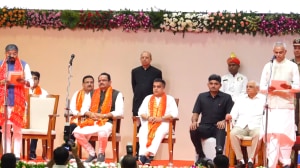No country is an island
This is the right time for India and the international community to think seriously about crafting a peace agreement in Sri Lanka.

This is the right time for India and the international community to think seriously about crafting a peace agreement in Sri Lanka. The history of the Sri Lankan conflict shows that neither of the two internal actors, namely the LTTE nor the government, can be relied on to make peace. Neither side has deviated from its ultimate goal: a separate Tamil state in the north east for the LTTE; and for the Sri Lankan government, it is to hold on to the territorial integrity within a centralised unitary setup. The problem is neither side is powerful enough to win nor weak enough to lose the war but both believe that they can win militarily.
How does one break the cycle? One view is that peace negotiations are possible only when there is a balance of power between the rebels and the government. The two warring sides in Sri Lanka have subscribed to this notion, but military parity has not brought an enduring peace, rather negotiations were used to regenerate military prowess, for example in 1985, 1987, 1989, 1994 and 2002.
The opposing view is that successful conflict resolution requires an imbalance of power, with the government having the upper hand. However, imbalance increases the incentive for governments to mount an all-out effort to crush the rebels — aptly captured by the Sri Lankan conflict.
It is time to try a different tack altogether. We need to start from the assumption that both sides are trapped in a cycle of conflict, and cannot break free without external intervention. The main ingredients for successful peace are well known: agreements that involve power sharing, representation, reconciliation and a longer term attempt to rebuild a common nation, underwritten by strong external guarantors. But for it to work, as conflict resolution expert Stephen Stedman points out, a common element among successful cases is the unity and coordination among external parties in defining the problem, establishing legitimacy for the strategy and applying the strategy. In Sri Lanka, the involvement of India is key to doing all three.
But for India to succeed this time, when it failed spectacularly in the late 1980s and lost hundreds of Indian peace keeping soldiers and a former prime minister to an LTTE suicide bomber, three things are necessary. First, the external actors must speak in one voice. The international community namely Japan, the EU and the US (in order of their importance in the conflict) must agree and actively back the Indian position that Tamil grievances must be addressed within, not outside, the territorial integrity of Sri Lanka.
Second, the international community and India must back a feasible strategy to stop funding the conflict. Backing means that they must stop all arms transfers to the two sides, curb fundraising by the LTTE in the diaspora, and vet all investments in stock markets. Estimates by the Strategic Foresight Group are that the LTTE spends $200-$350 million per year on its military. The funding comes partly from illegal activities and partly from the diaspora Tamils and a host of legitimate investments, such as investments in the money markets.
Third, India should emerge front and centre in helping the two combatants to craft a political solution. India is involved and cannot afford to have failed states on its borders. The episodic influx of refugees (150,000 from the north-east) into Tamil Nadu and the use of the state as a conduit for arms smuggling to the LTTE, and the more recent use by the LTTE of the Indian stock markets make it impossible to ignore the Sri Lankan crisis. India should use arguments of economic incentives to force the two sides to compromise.
For the government, the main incentive is to take advantage of the global shift towards the economies of Asia. Sri Lanka cannot ride on the wings of India’s economic surge unless it breaks away from the cycle of suicide attacks. A March 2007 suicide bombing saw a Rs 12 billion plunge in the value of the Sri Lankan stock market. For the LTTE, the reverses in the east, deaths of top leaders such as Anton Balasingham, and split with the Karuna faction have taken a toll on its morale. Even though previous attempts have failed, significant devolution backed by international guarantees could function as incentives for LTTE’s cooperation.
With the government holding the military advantage, this is the time for India to lean on the Sri Lankan President Rajapakshe to actively craft a political solution, rather than preparing for a military strike. As former Prime Minister Ranil Wickremasinge pointed out, an all party group set up in 2006 to discuss a political solution to the crisis has not yet resolved the final draft. This could be the first step. Indian diplomats are already engaged in back-channel communications with Tamil (LTTE and anti-LTTE) and Sinhalese groups. These efforts will help generate a longer term process of reconciliation between Tamil and Sinhalese citizens and create a common Sri Lankan identity.
The writer is fellow, Centre for Policy Research, New Delhi





- 01
- 02
- 03
- 04
- 05


























